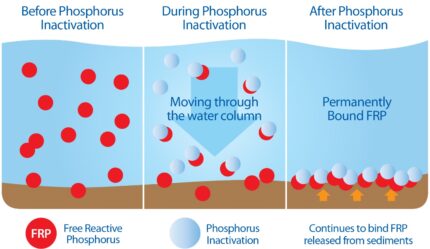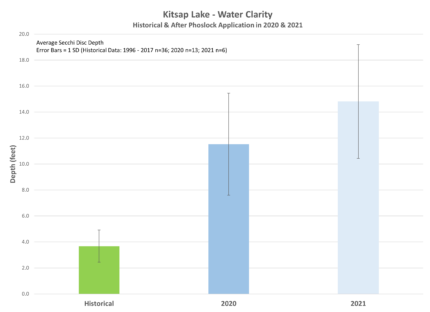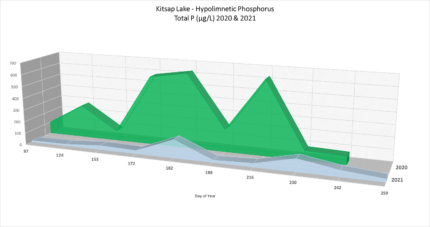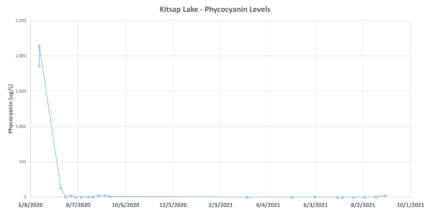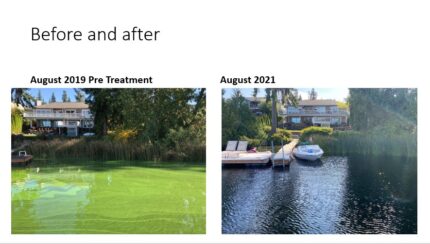by Terry McNabb, AquaTechnex
As most lake watchers know, Harmful Algae Blooms (HABs) caused by cyanobacteria are an increasing problem in Washington State. As phosphorus pollution increases in our lakes and reservoirs, cyanobacteria gain a competitive advantage and thrive. During blooms, these species can produce both acute and chronic toxins.
News articles each year talk about dogs dying soon after a visit to a local lake, and there have been cases of livestock and wildlife mortality around affected lakes. In the southeastern United States, a species of cyanobacteria has been directly linked to waterfowl and raptor deaths. This cyanobacterium grows on hydrilla plants that are ingested by coots and other waterfowl and cause brain vacuoles to form. As they lose their motor skills, the birds become easy prey for eagles and other raptors. This fatal disease then moves up the food chain. It’s not a stretch to think similar impacts could affect humans.
Concerningly, compounds produced by these species are linked to an elevated risk of ALS (https://pubmed.ncbi.nlm.nih.gov/28470570/ and other sources). There are clusters of ALS cases around reservoirs with historical cyanobacteria blooms. Furthermore, it is now understood that these toxins can be airborne: studies have shown toxins can be detected up to ten miles downwind of affected lakes under light wind conditions.
The common response to HABs blooms is to close the lake. State or local agencies post notices that the toxins are present, and that the lake should not be used. In other cases, expensive studies are undertaken using funds that might have been better spent on solving the problem. These studies often result in expensive treatments that project years or decades of restoration. When implemented, the longevity of the treatment often doesn’t meet its objective.
It is well understood that sequestering phosphorus is the primary solution for lakes impacted by HABs blooms. AquaTechnex has begun a new approach — using adaptive management strategies to target and remove phosphorus.
Adaptive management collects the information necessary to build a phosphorus mitigation program, builds a prescription, applies the prescription to capture phosphorus, samples the results, and builds a new prescription for the following year. This can be a much better use of limited funding and starts to deliver results right away. Over time, this approach can often be much more cost effective.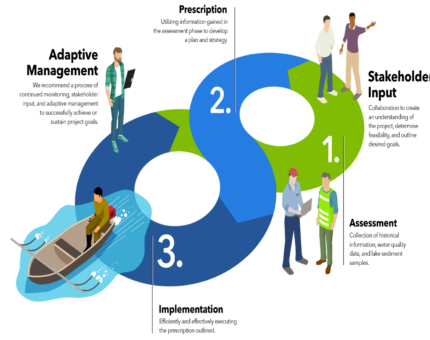
Using adaptive management at Kitsap Lake
Kitsap Lake in Bremerton, WA is a 245-acre water body that has historically been impacted by HABs issues including closure. In 2019, the City of Bremerton issued an RFP to develop a phosphorus management plan and Aquatechnex’s team won that competition. Aquatechnex proposed two options to the City and the Lake Steering Committee: an alum treatment, or the use of lanthanum-based technology. Alum has historically had issues with fish kills and the Washington Department of Ecology permit requires extensive monitoring during and after treatments. The community picked lanthanum as its preferred option.
Lanthanum is applied to the lake surface. As it contacts phosphorus (P) in the water column, the phosphorus is bound and a new mineral called Rhabdophane is formed. That phosphorus will never be biologically available again. As the lanthanum settles to the lakebed, it becomes incorporated into the upper lake sediments and continues to capture P, in effect capping the sediments.
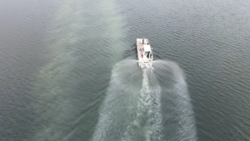 Using bathymetric maps, lake water column and sediment phosphorus sampling and calculations, we developed and implemented a lanthanum application in the summer of 2020. Lanthanum was applied in June to target water column phosphorus and in early August to target phosphorus build-up in the hypolimnion. The results were a HAB-free summer for the community. Samples collected over the winter allowed us to develop our 2021 treatment approach using Adaptive Management techniques and a similar program was implemented in 2021 using considerably less lanthanum.
Using bathymetric maps, lake water column and sediment phosphorus sampling and calculations, we developed and implemented a lanthanum application in the summer of 2020. Lanthanum was applied in June to target water column phosphorus and in early August to target phosphorus build-up in the hypolimnion. The results were a HAB-free summer for the community. Samples collected over the winter allowed us to develop our 2021 treatment approach using Adaptive Management techniques and a similar program was implemented in 2021 using considerably less lanthanum.
Before treatment, the average Secchi disc measurements on the lake averaged three feet. In 2020 there was a three-fold improvement and in 2021 there was a four-fold improvement with the average measurements in the 14-foot range.
Hypolimnetic phosphorus levels were reduced dramatically by targeting sediments in the deeper portion of the lake. In August of 2020, total phosphorus was reduced from 600 ug/l to under 40 ug/l. In the summer of 2021, total P levels maintained low levels in the 30-40 ug/l range.
Phycocyanin measurements were also collected during these two years. Phycocyanin is a pigment unique to cyanobacteria that can be a measurement of biomass. Phycocyanin levels were above 2,000 ug/l before the 2020 application and have been measured near zero in all sampling events since the initial treatment.
Lanthanum is a very effective phosphorus sequestering technology.
Three new products enter the marketplace this year. In February we started using Eutrosorb WC, which is a solution of phosphorus-binding minerals to strip water columns of phosphorus. This summer Eutrosorb G will reach the marketplace. Eutrosorb G is a high-efficiency lanthanum-modified bentonite formulation for binding phosphorus. Lastly, Eutrosorb SI is a liquid formulation of phosphorus-binding minerals for sediment phosphorus inactivation that will also be available this summer.
For more information, please contact tmcnabb@aquatechnex.com or 360-527-1271


